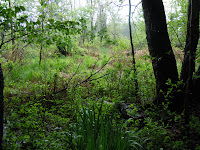Pretty abruptly the habitat and terrain changed yet again. Now the trail became hilly, being former dunes. This area became more oak (Quercus sp.) dominated and it also where I came across this odd ball…
This
hash-brown of a plant actually stumped me from my discovering it until about a
week from my writing this post. It is a non-photosynthetic parasite called
Squaw or Cancer Root (Conopholis Americana). After finding the first one, I got
a big head and thought I had found some rare late succession dune plant. I
continued feeling high for about 50 yards when I saw this…
…maybe not so rare. But it was still really cool and new to me so I still felt high. It was also in this area, which is near the end of the trail, that I came across a raging stream. Even though it was just a creek, it was rushing very fast and the sound carried for some distance. Let me put this in perspective though. The day after this trip occurred it rained hard again. I returned to the area briefly during summer and discovered that the sturdy wood bridge which the trail crossed the creek with had been washed away. At this time it was nearly 4 feet wide and 3 feet deep, fast running, and impossible to see through. When I made my summer check back, it was a whopping one foot wide, two inches deep and the entire creek bed was visible.

 Besides
spending way too much time marveling at the water (I’ve got a thing for running
water) the whole pocket created created by winding dunes, dense old growth trees,
and the creek was absolutely serene. It was this location that inspired what
was to be the original title, “A Slice of Paradise.”
Besides
spending way too much time marveling at the water (I’ve got a thing for running
water) the whole pocket created created by winding dunes, dense old growth trees,
and the creek was absolutely serene. It was this location that inspired what
was to be the original title, “A Slice of Paradise.” Honestly
of all the trips I took this felt like the longest. But soon I made my way back
to the train, classes, and society. I really had no idea this would be my last
trip to the IN dunes to date but I think it was quite satisfactory, even
fitting, as a finale to the first chapter of my adventures on the shores of
Lake Michigan and this blog. While I will be returning (as frequently as I can)
I intend to shift the focus of this blog northward. Illinois dunes in the
northernmost suburbs of Chicago are very different in character from those to
the south of Chi town in Indiana but no less interesting, exciting, and (for
most of us) new. I hope you enjoyed reading and I look forward to bringing you
the next wave of adventures.
Honestly
of all the trips I took this felt like the longest. But soon I made my way back
to the train, classes, and society. I really had no idea this would be my last
trip to the IN dunes to date but I think it was quite satisfactory, even
fitting, as a finale to the first chapter of my adventures on the shores of
Lake Michigan and this blog. While I will be returning (as frequently as I can)
I intend to shift the focus of this blog northward. Illinois dunes in the
northernmost suburbs of Chicago are very different in character from those to
the south of Chi town in Indiana but no less interesting, exciting, and (for
most of us) new. I hope you enjoyed reading and I look forward to bringing you
the next wave of adventures.See you in the field!























